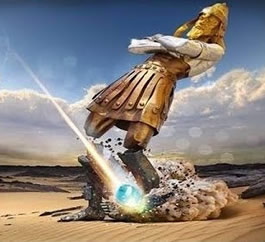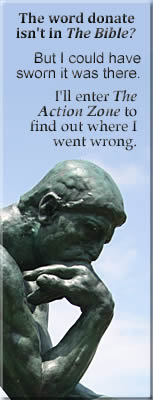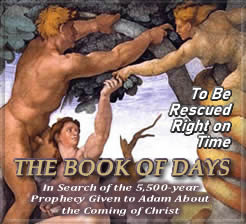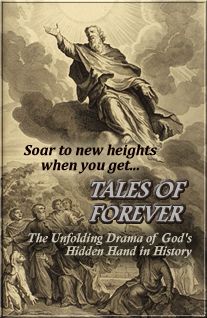The Kingdom of Stone (Cont’d)
The Stone Became a Mountain and Filled the Earth
As Jews living through decades of Roman domination, the disciples of Jesus, like generations before them, were anticipating divine deliverance at the hands of a messianic figure. According to prophecies in such works as The First Book of Enoch, an all-powerful figure—the Son of Man, as Enoch called Him—was supposed to topple whatever government existed at the time of His arrival and restore the nation of Israel as the dominating force in world history.
The prophet Daniel also spoke of this Son of Man Who would be given “dominion, glory, and kingship, that the people of every nation and language should serve Him. His dominion is an everlasting dominion that won’t pass away, and His kingdom is one that will never be destroyed.”1 As biblical scholars will all tell you, the Roman Empire was not the only kingdom to have oppressed the nation of the Jews. According to Daniel, four great empires were to dominate the southern kingdom of Judah. We know this because the king of the first empire had a disturbing dream, which Daniel alone, among all the wise men of Babylon, was able to interpret. Said Daniel to King Nebuchadnezzar:
As you were watching, oh king, a great statue appeared. A great and dazzling statue stood before you, and its form was awesome. The head of the statue was pure gold, its chest and arms were silver, its belly and thighs were bronze, its legs were iron, and its feet were part iron and part clay.
As you watched, a stone was cut out of a mountain, but not by human hands. It struck the statue on its feet of iron and clay, and crushed them. Then the iron, clay, bronze, silver, and gold were shattered and became like chaff on the threshing floor in summer. The wind carried them away, and not a trace of them could be found. But the stone that had struck the statue became a great mountain and filled the whole Earth.2
Story Continues Below
Says Richard Price—the founder and CEO of Academia.edu—on his podcast In Depth With Academia:
On Earth as It is On Heaven: The Promise of America, Technology, and the New Earth is:
To hear Price’s book review of On Earth as It is On Heaven, CLICK HERE.
To watch author and historian W. Kent Smith discuss the contents of his book On Earth as It is On Heaven, at the Sacred Word Revealed Conference ‘23, hosted by Zen Garcia, CLICK BELOW.
Story Continues From Above
Daniel went on to explain the meaning of the king’s dream, saying that this great statue represented four empires, of which Babylon was the head of gold, and which would be followed by three more empires. These kingdoms, say biblical scholars, quite unanimously, are revealed later in The Book of Daniel to be Medo-Persia, Greece, and Rome.3
But what scholars are not so unanimous about is the identity of the Kingdom of Stone. Said Daniel:
In the days of those kings, the God of Heaven will set up a kingdom that will never be destroyed, nor will it be left to another people. It will shatter all these kingdoms and bring them to an end, but will itself stand forever. And just as you saw a stone being cut out of the mountain without human hands, and it shattered the iron, clay, bronze, silver, and gold, so the great God has told the king what will happen in the future.4
One of the great mysteries of biblical prophecy, this Stone Kingdom is rarely if ever spoken of in any sermon or commentary. More often than not, though, if the subject is broached, we’re told that this kingdom represents the Second Coming of Christ. The only problem with that interpretation is this is only possible if you twist Daniel’s method of interpretation. Clearly, Daniel intended his listeners to understand that the imagery of Nebuchadnezzar’s dream of the Great Image represents earthly kingdoms. Nothing at all indicates that the symbolism contained in the dream has shifted, or else why not simply do what Daniel did seven chapters later in his description of four beasts that also represent Babylon, Medo-Persia, Greece, and Rome? There, when Jesus arrived on the scene of biblical prophecy, Daniel plainly stated that One like the Son of Man took His place on the stage of world history.
Of course none of this is new when it comes to the foibles of interpreting biblical prophecy. Due to the ambiguous nature of the symbolism contained in Scripture, one is always faced with the question of how to approach what God means to reveal. Here again we come face to face with the paradoxical nature of God’s word. And again this ambiguity, which spawns all kinds of inconsistencies in interpretation, is something that critics and skeptics of The Bible love to pounce on, in their insistence that nothing in Scripture can be depended on to reveal truth.
But if God exists and He’s revealed His truth in Scripture, then don’t you think He’s aware of the ambiguous nature of that message? Of course He is; so evidently this is how God has purposely designed it. Had He chosen to be more specific, then certainly He’d have spelled out His message as plainly as the nose on your face. But in couching His word in such symbolism, it inevitably forces us to search long and hard for its true meaning. Clearly King Solomon had this in mind when he said, “It’s the glory of God to conceal a matter and the honor of kings to search it out.”5








